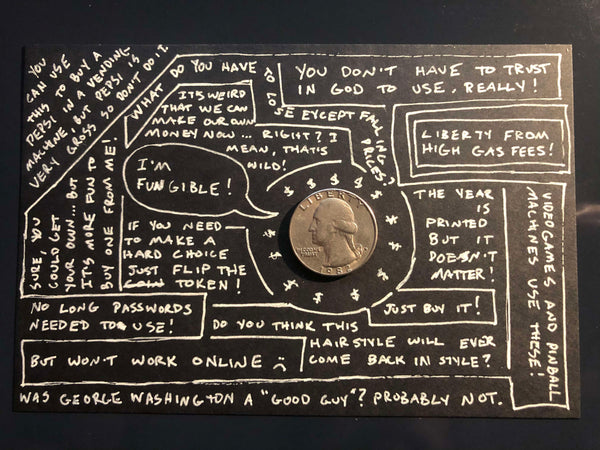
Headlines abound with the promise of riches in the NFT boom, but after a boom comes a bust, or more gently, a "market correction." With the re-introduction of non-cryptographic tokens you can shield yourself from the wild swings of speculation and best of all avoid those high gas fees (be warned that gas prices are expected to continue to rise).
So what is a "fungible token"? Well, unlike an NFT there is nothing especially unique about fungible tokens. Each token holds a set amount of value that does not change. How can a token hold an even price? Well, it's by decree of the United States Government and is backed by a monopoly on legal violence. This special contract allows the government the right to decide the freedom of any citizen and also the value of any token they issue.
So this is pretty wild... even if you buy a 0.25 Unit Fungible Token for .55 ETH the actual value of the token itself remains at 0.25 USD. And, on top of that, this is all done off chain and with no smart contract.
What You Are Actually Buying:
One token that has been minted by the government and backed by the threat of state violence. This token has no serial number and is 100% FUNGIBLE! Each token can only ever be worth 25% of the value of a USD Coin. It is marked by the date it was minted.
Some tokens are part of limited edition drops and highlight one of the fifty states. Strangely, these special top tokens have no additional value.
Note: Special edition tokens are shipped at random.
Recognition From Important People and Sources:
Mark Frauenfelder of Boing Boing says,
"This cool fungible token is made of metal and it's just 25 cents!"
Carley Tennes of Cracked.com says,
"... avant-garde entrepreneur Mike Merrill has an answer to our burning inquiry..."
Bruce Sterling, on his private twitter account says,
"Hey, nice parody there, that one's genuinely clever"
(we object to the idea of being described as a parody, but as fans of Mr. Sterling, we are flattered by his attention)
Additional Notes:
Ecological Concerns: On October 5, 2009, President Barack Obama signed Executive Order (EO) 13514, Federal Leadership in Environmental, Energy and Economic Performance. EO 13514 established “an integrated strategy towards sustainability in the Federal Government” by requiring all Federal agencies to achieve a series of sustainability goals “in order to create a clean energy economy that will increase our Nation’s prosperity, promote energy security, protect the interests of taxpayers, and safeguard the health of our environment.”
Sustainability projects that reduce the United States Mint’s energy, water and material use during coin production cut costs. These sustainability projects have the added social benefits of reducing air pollution, water pollution, solid waste, and greenhouse gas emissions.
Over the past few years, the Mint has made substantial changes to their buildings and production operations to lessen their carbon footprint, and their sustainability projects have shown positive results. Over the years, they have reduced or recycled waste, conserved energy by retrofitting several plants, and eliminated some carcinogenic chemicals used in production. The Mint had the following recent major sustainability accomplishments:
The San Francisco Mint reduced water consumption in the chemical washroom, eliminated ethyl alcohol usage, and reduced blank and coin quality issues. As a result of the team’s efforts, we reduced water consumption in the chemical washroom by more than 90 percent and reduced overall building water consumption by 42 percent (an average of 126,785 gallons per month).
The Denver Mint also reduced water usage and was awarded its fifth environmental Gold Award in April by the Metro Wastewater Reclamation District, the wastewater treatment authority for much of metropolitan Denver and parts of northern Colorado. The Gold Award recognizes Denver for being in full compliance with pretreatment requirements and a having a demonstrated commitment to environmental excellence. Although these are strict requirements, the Denver Mint received the award previously in 1999, 2007, 2010, and 2011.
The Mint’s 2011 Sustainability Report is the first sustainability report published by the Mint, which updates the bureau’s stakeholders on its performance in achieving EO 13514’s sustainability goals. It also includes the Mint’s first detailed, public disclosure on workforce health and safety.
